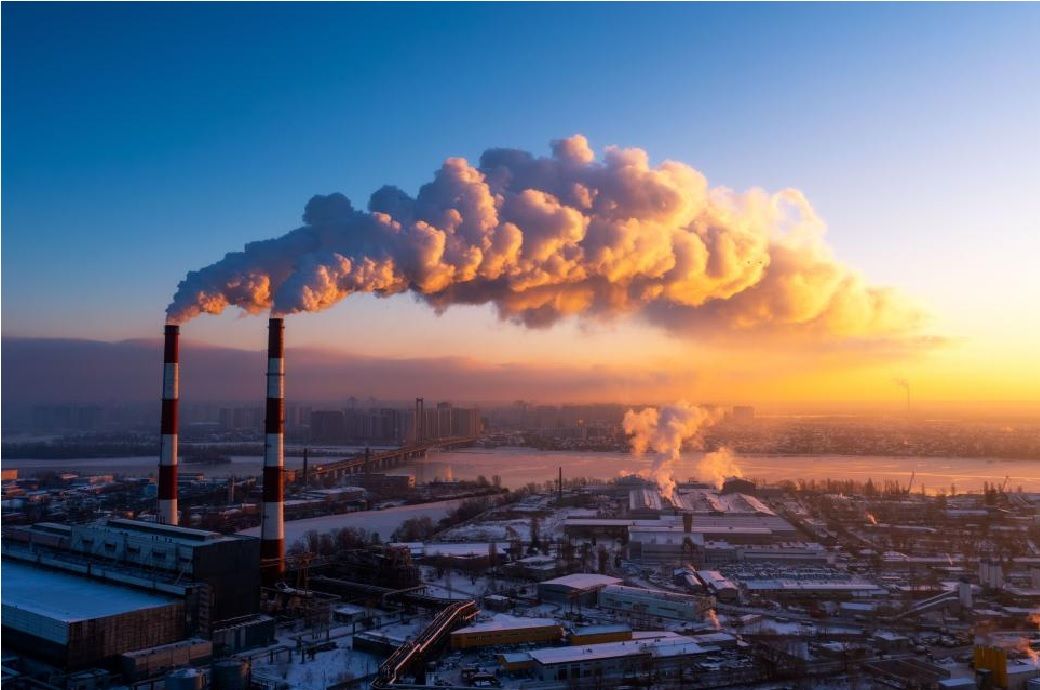Fashion
GHG emissions hit record high in 2024 despite declines in EU, Japan

Over the same period, the EU’s GHG emissions, excluding LULUCF, shrank by 1.8 per cent, that is by close to 60 Mt CO2 eq. GHG emissions from China and the US remained relatively stable.
EDGAR findings are published in the JRC report ‘GHG emissions of all world countries’ compiled in cooperation with the International Energy Agency (IEA). The report presents trends from 1990 to 2024, together with emissions and removals from LULUCF and wildfires. It provides a factsheet for all the countries in the world and the EU, including sector-specific trends and trends per capita and GDP.
Global GHG emissions hit a record 53.2 Gt CO₂eq in 2024, up 1.3 per cent, driven by major emitters like India (+3.9 per cent) and Indonesia (+5 per cent).
Only the EU and Japan saw notable declines.
The power sector led emission growth, while global emission intensity per GDP fell.
LULUCF acted as a small net source due to wildfires, despite large removals from forests.
The EDGAR report shows that global GHG emissions from anthropogenic activities have increased by nearly 1.5 per cent annually on average since 1990, and as a result are 65 per cent higher in 2024 than in 1990.
In 2024, the eight highest emitting economies – China, US, India, EU, Russia, Indonesia, Brazil and Japan – collectively contributed to 66.2 per cent of global GHG emissions. Only the European Union and Japan decreased their emissions compared to the previous year (-1.8 per cent and -2.8 per cent respectively), while all others either kept them rather stable (China: +0.8 per cent; US: +0.4 per cent; Brazil +0.2 per cent) or increased them (India: +3.9 per cent; Russia: +2.4 per cent, Indonesia: +5 per cent – the highest relative increase).
In absolute terms, India has the largest increase with 164.8 Mt CO2eq more emissions released in 2024 compared to 2023.
Nevertheless, all major emitters reduced their emission intensity in terms of GHG emissions per unit of GDP.
The EU has continued its decades-long decreasing trend of GHG emissions, briefly interrupted only in 2021 by the post-COVID rebound. On a longer perspective, data for the EU show the most significant percentage decrease of GHG among the top emitting economies since 1990, while GDP based on purchasing power parity (PPP) grew steadily in the same period.
Beyond the EU, other major economies also show signs of decoupling emissions from economic growth. While GDP PPP has grown strongly in all regions since 1990, the pace of emissions growth has been lower, leading to declining emission intensity.
The US, Russia and Japan have gone further, achieving absolute decoupling: in 2024 their GDP PPP was significantly higher than in 1990, while their GHG emissions were lower.
By contrast, India and China experienced rapid GDP PPP growth accompanied by rising emissions, although at a slower rate than GDP PPP. These contrasting trajectories underline that while absolute decoupling remains challenging, it is already a reality in several major economies.
China, the US, India, the EU, Russia, Indonesia, Brazil and Japan were the eight largest GHG emitters in 2024, according to the report. Together they account for 54.6 per cent of the global population, 68.3 per cent of the global GDP PPP, 68.3 per cent of the global primary energy consumption of fossil fuels (coal, oil, and natural gas), and 66.2 per cent of the global GHG emissions.
Only five of the 18 countries and regions that contribute more than 1 per cent to the total global GHG emissions reduced their GHG emissions in 2024: the EU27, Japan, Mexico, Germany, and South Korea.
According to the report, the power industry emissions showed the largest absolute increase (+235 Mt CO2eq or +1.5 per cent) in 2024 as compared to 2023, whereas fuel exploitation had the largest relative increase (+1.6 per cent). All other main economic activity sectors also increased their emissions or remained stable: industrial combustion and processes, buildings, transport, agriculture, and waste.
Atmospheric CO2 can accumulate as carbon in vegetation and soils, which act as sinks. Human activities have an impact on these sinks through the LULUCF sector.
Globally, the LULUCF removed about 1.3 Gt CO2eq in 2024, excluding wildfires, which is equivalent to 2.4 per cent of 2024 global GHG emissions. When including wildfires, the LULUCF sector results in a source of 0.9 Gt CO2eq.
This net flux reflects the balance between much larger removals, mostly from managed forests (about 5.5 Gt of CO2 in 2024, equal to 13.9 per cent of total anthropogenic CO2 emissions excluding LULUCF), and emissions, primarily from deforestation (about 3.7 Gt CO2, approximately 9.3 per cent of the same figure).
Fibre2Fashion News Desk (RR)
Fashion
US textile imports steady as Cambodia, Bangladesh gain market share

China retained its position as the largest supplier with a **.** per cent market share, followed by Vietnam at **.** per cent. However, China’s share continued to slide month after month, reflecting a structural shift in sourcing. American buyers are increasingly diversifying towards Southeast and South Asia to reduce tariff exposure, mitigate geopolitical risk, counter rising production and labour costs, and build more resilient supply chains.
During January–September ****, apparel imports—the dominant product category—rose by *.** per cent to $**.*** billion, compared with $**.*** billion in the corresponding period of ****. In contrast, non-apparel imports fell by *.** per cent to $**.*** billion, as slower housing activity, cautious consumer spending, and order rationalisation by retailers softened demand for home textiles, industrial textiles, and made-ups.
Fashion
Calvin Klein opens new global flagship store in New York’s SoHo

Located at 530 Broadway in the heart of SoHo, the 3,000+ square foot selling space reaffirms Calvin Klein’s commitment to creating premium lifestyle destinations that marry the brand’s distinctive minimalism with authentic local energy. The store’s design was inspired by New York City’s signature loft apartments, creating a modern, warm environment that evokes the creative legacy of downtown New York and provides an ideal backdrop for the essential denim, underwear and apparel synonymous with the brand – while reinforcing Calvin Klein’s deep roots in the city.
Calvin Klein has opened its new global flagship at 530 Broadway in New York’s SoHo, marking a major brand homecoming and reinforcing its global lifestyle positioning.
The loft-inspired space highlights denim, underwear, apparel and accessories, alongside campaign-driven displays.
A limited-edition Calvin Klein Soho capsule debuts now, with Calvin Klein Collection pieces arriving from Spring 2026.
David Savman, Global Brand President, Calvin Klein said, “We are proud to return to one of the world’s most fashionable cities – and the birthplace of our iconic brand – with an elevated retail expression. This new global flagship, located just steps from our landmark Houston Street billboard, is a tribute to Calvin Klein’s New York heritage. It represents both the evolution of our retail experience and a tangible expression of the world of Calvin Klein. Calvin Klein embodies a distinctive, global way of living that meets culture, and this store is the latest step on our journey of taking our brand to the next level.”
“New York is central to the DNA of the Calvin Klein brand,” said Stefan Larsson, CEO, PVH Corp. “This homecoming is a key milestone as we build Calvin Klein into one of the most desirable lifestyle brands in the world. Step by step, we’re deepening brand relevance, driving consumer engagement and strengthening brand positioning across North America and globally.”
The store showcases Calvin Klein’s lifestyle offering through curated spaces framed against the latest marketing campaigns. Denim and underwear anchor the experience, complemented by men’s and women’s apparel and accessories to round out the world of Calvin Klein. Key styles from Calvin Klein Collection, the pinnacle expression of the brand, will be available during designated times beginning in Spring 2026. As part of the opening, the store will house a limited-edition capsule featuring tees, fleece sweatshirts, hats and totes emblazoned with custom Calvin Klein Soho branding in navy, cobalt, grey and white colorways.
Note: The headline, insights, and image of this press release may have been refined by the Fibre2Fashion staff; the rest of the content remains unchanged.
Fibre2Fashion News Desk (RM)
Fashion
US container imports drop 5.4% in November: Descartes

US container imports fell 5.4 per cent MoM to 2.18 million TEUs in November 2025, driven mainly by an 11.3 per cent decline from China.
Volumes were also 7.8 per cent lower YoY, though still the fourth-strongest November on record.
Southeast Asia posted solid growth, but China’s sharp contraction dominated, signalling a cautious year-end outlook amid trade and shipping uncertainty.
Source link
-

 Politics6 days ago
Politics6 days agoThailand launches air strikes against Cambodian military: army
-

 Tech1 week ago
Tech1 week agoWIRED Roundup: DOGE Isn’t Dead, Facebook Dating Is Real, and Amazon’s AI Ambitions
-

 Sports1 week ago
Sports1 week agoAustralia take control of second Ashes Test | The Express Tribune
-

 Politics6 days ago
Politics6 days agoZelenskiy says Ukraine’s peace talks with US constructive but not easy
-

 Fashion6 days ago
Fashion6 days agoGermany’s LuxExperience appoints Francis Belin as new CEO of Mytheresa
-

 Politics1 week ago
Politics1 week ago17 found dead in migrant vessel off Crete: coastguard
-

 Business1 week ago
Business1 week agoNetflix to buy Warner Bros. film and streaming assets in $72 billion deal
-

 Politics3 days ago
Politics3 days agoTrump launches gold card programme for expedited visas with a $1m price tag


















